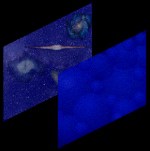
(click for animation)
A six-year-old controversial theory that told of a time before the Big Bang is undergoing a resurgence, only to be lampooned again by its original critics.
The theory of ekpyrotic cosmology was first put forward as an alternative to the standard “inflation” model of the universe. Inflation supposes that just after the Big Bang the universe underwent a brief period of rapid expansion. This amplified tiny density perturbations, which evolved into the stars, galaxies and galaxy clusters we see today. Although there is currently no way to prove that inflation ever occurred, the fact that it provides such a simple explanation for cosmic structure and the flatness of the universe has cemented it in cosmological doctrine since it was outlined in the early 1980s.
In ekpyrotic cosmology — which was proposed in 2001 by physicists Paul Steinhardt, Justin Khoury, Neil Turok and Burt Ovrut — there is no beginning of time. Instead, our visible universe exists on one of two four-dimensional “branes” floating in a five-dimensional space. These two branes are locked in an endless oscillatory motion in which they creep together, “bounce” through each other, withdraw and then creep together again (see animation: Branes collide). At each bounce, which is like a fresh Big Bang, ripples in the branes collide and liberate energy at different places to produce the initial density perturbations. And because energy conservation would favour a flat brane, the theory explains why our visible universe is flat too. “It’s like the antichrist to inflation,” says Khoury.
Past critics of ekpyrotic cosmology, however, have highlighted two particular problems. First, every bounce would be a point of infinite temperature and pressure known as a singularity, which is impossible to describe using conventional physics. Second, it was not clear that the density perturbations would be present on all length scales, as observations of the primordial radiation left over from the Big Bang — that is, the cosmic microwave background — indicate they should be.
‘From A to Z’
It’s like the antichrist to inflation Justin Khoury, Perimeter Institute
Now, Khoury and Evgeny Buchbinder, who are currently at the Perimeter Institute in Waterloo, Canada, with Ovrut, who is at the University of Pennsylvania in the US, say they have overcome these problems. Building on work performed in 2006 by Leonardo Senatore, Paolo Creminelli and others, the researchers say they can bring density perturbations “unscathed” through a bounce while leaving them scale-invariant on the other side. “For the first time we’re able to track the story from A to Z,” says Khoury.
Physicists have managed to get around the sharp bounce singularity in the past, but not without generating undesirable negative-energy particles. By merging ekpyrotic cosmology with a scalar field known as a ghost condensate, Khoury’s group claim to suffer no such complications. This field, which manifests as a fluid of massless particles in the same quantum state that permeate space with repulsive gravity, can smooth out the bounce.
On its own, though, a ghost condensate cannot keep the density perturbations scale-invariant. To do this, Khoury’s team invoke another scalar field. It turns out that the difference between the entropy fluctuations in this field and those the ghost-condensate field yields unambiguously scale-invariant perturbations (Phys. Rev. D 76 123503).
Stiff opposition
These ideas are barking up the wrong tree Nima Arkani-Hamed, Harvard University
The original criticisms of ekpyrotic cosmology were spearheaded by Andrei Linde of Stanford University in the US, and he has little praise for “new ekpyrotic cosmology” either. He claims that the theory is still plagued by negative-energy particles, which lead to a “catastrophic” instability in the early universe’s vacuum (arXiv:0712.2040v2). “The universe described by this theory instantly dies,” he told physicsworld.com. “Therefore it does not even come close to describing our world.”
Khoury insists that Linde’s argument is wrong because he does not acknowledge that particle physics theories are effective, in that they only ever work over a finite range of energy scales. “He’s predicting something by trusting the theory beyond the point where it should be trusted,” explains Khoury. “By contrast, at all times in our description of the bounce, the universe is at a sufficiently low energy that we can trust the ghost condensate description.”
Nima Arkani-Hamed of Harvard University, who first formulated the theory of ghost condensates, sides with Khoury’s group. Nevertheless, he thinks that new ekpyrotic cosmology is too complicated to rival inflation, and admits that he has “poked fun” at Senatore and Creminelli — his former post-docs — for their attempts to tackle the theory. “I believe these ideas are barking up the wrong tree,” he told physicsworld.com. “But they are definitely worth working with, they are interesting and clever.”



